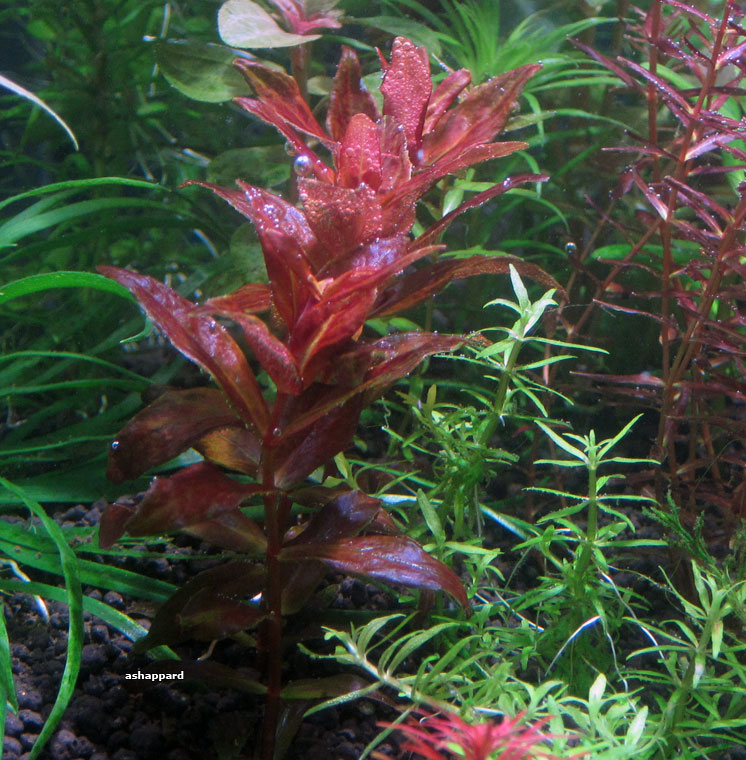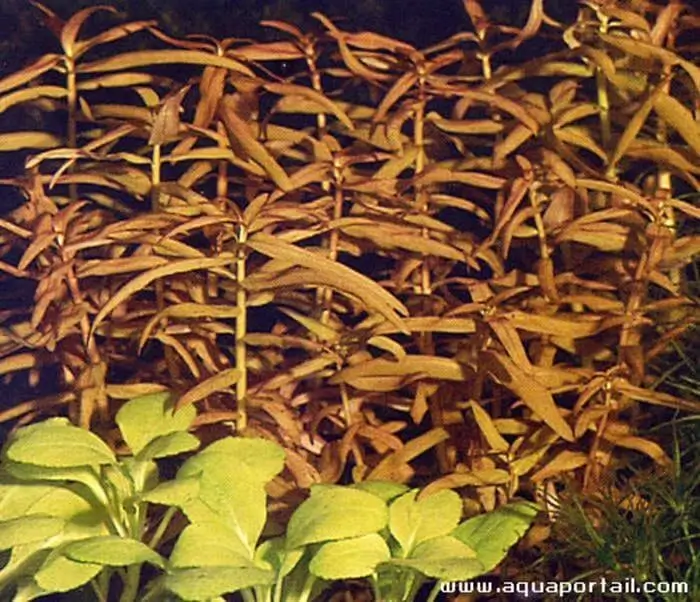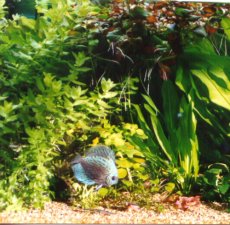If you think I'm going to use the the theme of coloration in fishes as a cheap excuse to talk about red plants you'd be dead right. I have no idea if red plants will make your half moon platies more blue and frankly I don't really care - I just like red plants ("the killifish of the plant kingdom") and will use any excuse to talk about them.
What makes plants green? That's easy, chlorophyll. What makes plants red then? Well, that depends on the plant, there's more than one pigment involved. Plants in the Carnation order are red because of a pigments called betalains. Betalains get their name from red beets (the genus Beta in the Chenopodiaceae), which are red in color due to the presence of the betalain. The red color in most other plants produced by water-soluble flavonoid compounds called anthocyanins. Either way you probably don't care, red plants are red because they have red pigments.

Will red light or blue light make my red plant redder? No, BRIGHT light will make your red plant redder. You'll have redder plants with (very) strong green light than you will with red and/or blue light. Keep in mind a plants shape is more affected by the color of light - an excess of blue light will tend to promote compact growth while an excess of red light will promote more elongate growth. I tend to lean a bit toward the blue when I'm mixing fluorescent tubes and 6500 degree Kelvin tubes are commonly available now as are 5000 degree tubes. 7500K tubes are a little tougher to find in hardware shops but pet specialty and lighting distributors cab get them. The 10K tubes for marine use are not terribly good for freshwater tanks, there's just too much blue light there. Blue light is also important if your water is colored by tannins from say, peat, oak leaves, ceder root or the like.
That peat water is yellow suggests that is scatters yellow light and absorbs the red and blue. Additional blue light should overcome this. Now, green plants look green because them absorb primarily red and blue, and reflect the green component of light back. Red plants are reflecting red light back. They're not absorbing it. Seems to me for whatever reason, they're more efficient at absorbing blue light. I always have extra blue lights over tanks with red plants. All things being equal with sufficient light, I think the addition of blue lights helps "turn up the red" a little bit.

| 
|
Do red plants need extra Iron? Eh... no. Yes. Maybe. Sorta. The red pigments, anthocyanins do not contain any iron, so a lack of that would not inhibit their formation, but, if the plant is in an iron poor environment and is one that is from a typically iron rich environment - which most tropical aquarium plants are, being from laterite rich tropical localities - then, it's conceivable that adding iron would make a less than healthy plant
a more red plant possibly leading to this conclusion. Red plants are red when they're happy - they're (dark) green when they're not. Not enough light or nutrients and your red plants won't stay red long.

| 
|
Are there enough plants to have a all red tank? Yeah, there are. Although in a minority, there are enough species of red aquarium plants with different textures and growth habits that you could conceivably set up a tank with all red plants. Now that's my idea of improving coloration in fishes, even female feeder guppies would look great in a tank like this. But, I've never seen one, in a book, in real life or on the web. It seems to me if you looked at enough Dutch tank photos on the web and cut and paste clumps of red plants you could make tone that way to see how you liked the idea. Hmmm, another project for a rainy day.
So what plants are there? Well, lets look at the whole spectrum of plants starting with the most simple: unicellular plants; algae. There's red algae. Oh boy. You don't want this stuff, ever. Next. Ok well there's no red floating plants and no red rootless plants so we can whiz on by those categories. What it comes down to is bunch plants and rooted plants.

| 
|
One of the largest bunch plants you'll ever see is Ammania gracilus. It's right up there with "temple" Hygrophila, but believe it or not can get even larger. Tom Barr reports leaves from 8-12 cm as common. Temple plants leaves are wider, to be sure, but how many times do
you see bunch plants with stems as thick as pencils. This thing is a monster. Only slightly smaller is A sengalensis, from, predictably, Senegal. Both are useful "indicator plants"; if/when the water quality takes a dive the plant will stop producing very symmetrical groth pattern, and while the plant will be fine once you fix the problem, the distorted growth will always be there. In this sense it's like having a sort of strip recorder. The Ammania species we see in aquaria are African, but Ammania is a widespread genus - Ammania species can be found in North America - but not aquatic species unfortunately.
 |
 |

| 
|
As long as we're in the A's lets have a quick look at Alternanthera. There are several species, not of which are true aquatics. It is possible to grow them well in aquaria, but they need a lot of help - light and nutrients closer that what those sorts of plants need when submersed: tremendous amounts of light and very very rich nutrients. These are not beginners plants, even though they're sold frequently to people that don't know better as "scarlet hygro". "Scarlet wont-gro" is more like it unless you have enough light to grow tomatoes and pot them in manure. Ok, they're not that bad but you get the idea. The two most common species you'll see sold as scarlet hygo are A. sessilis, "which absolutely refuses to grow under water" to quote Paul Krumbholtz and A. reineckii which can be cultivated submersed successfully. reineckii has a slightly lighter colored stem, and sessilis has a pronounced woody stem and is more red, reineckii has more of a pinkish brown hue to its upper leaf surface while the undersides are crimson/magenta. (Correction (2014) the one I was best able to grow was A. rosifolia - rjs).

| 
|
Moving along in the bunch plant category we stumble over to genus Rotala which has more than it's share of non-green plants. There's indica, which looks a bit like a mini hygrophilia and can take on a pinkish hue. There's wallichi which is a frilly bushy plant with very fine leaves. It looks like a long bottle brush sticking up out of your gravel; it's reddish brown. Both of these plants make for interesting texture and color when aquascaping. Then there's R. macranda, the granddady of red plants. This plant isn't red it's RED as in screaming scarlet, the-color-of-blood-in-the-movies red.
We take leave (no pun intended) of bunch plants now (yes, we're bypassing Ludwigia, it's only red underneath - that's cheating) and wander over to the eelgrass aisle. While it's not strictly red, "red marble val" or "red crystal val" has enough red marbled streaks in it to break up the monotony of any all-green tank. This is a large plant, think jungle val but a lighter shade of green tending towards yellow, with small red horizontal squiggles. The first few inches of all leaves at the base can be pink if there's enough light. Maybe it's just me but this plant seems to take a long time to become established in my tanks. The few times I've had it I've planted the poor thing, stripped of dead leaves, just sit there for months, then all of a sudden one day a year later you notice your val, that you thought had finally picked up and put out some bigger leaves at the surface has actually multiplied and nearly taken over your tank. Because it's such a large plant it gets put at the back and you might not not notice that while the plant has distracted you with interesting leaves at the top of the tank, it's been spreading little Vallisneria bombs in the gravel on runners and unlike the slow growing parent plant, these shoot up very quickly. The last time I had this plant I stored it "temporarily" in my wife's 40 gallon Endlers tank. When it was time to either throw it or me away, I pulled it all up and even in this small tank (it was a 40 long and not terribly tall) the plant has leaves over 4 feet long. How to fill a 65 gallon tank: plant a red marble val and wait. There's some shots of this plant from when I first got my digital camera which was right about the time it decided to start putting out new leaves, here: http://images.aquaria.net/plants/Vallisneria/Red-Marble/
Barclaya longifolia looks like some sort of a red swordplant modulo a different shaped leaf and it's not a terribly common plant - you seldom see it on stores. I will admit to killing the only one I ever had but I got it from a guy that had been maintaining a perpetuating culture of the plants in a 65 gallon tank. With an eel. Here's what he did to successfully reproduce the plant: nothing. They're quite happy to flower and set seed in aquaria if you let them. I remember seeing this tank of Barclaya before I moved to Los Angeles in 1980. When I returned to Canada a decade later the tank was still there and doing better than ever. Perhaps this does qualify as the elusive all-red tank - Charlie Drew you win some sort of award. Again.

| 
|
Despite the fact there's a "red" wendtii there aren't really any red crypts. There's lots of them that are brown, but none are red like, say, Rotala macranda. A couple have a scarlet purple underside, which half counts I guess. The crypts are a very diverse group and even trying to tackle a question like "ok, so which ones are the brown ones" starts out with "Um, depends..." and this group of plants will be the focus of a series of upcoming columns.
There are no red Aponogetons. Rats. (postscript 2014 - several red Australian Aponogetons.)
Last but not least there's Echinodorus. Recent years have seen a plethora of Echinodorus cultivars and there is a red one that in the right conditions is more of a burgundy or red-wine color than scarlet, but hey red is red and we'll take it in any form we can get it.

